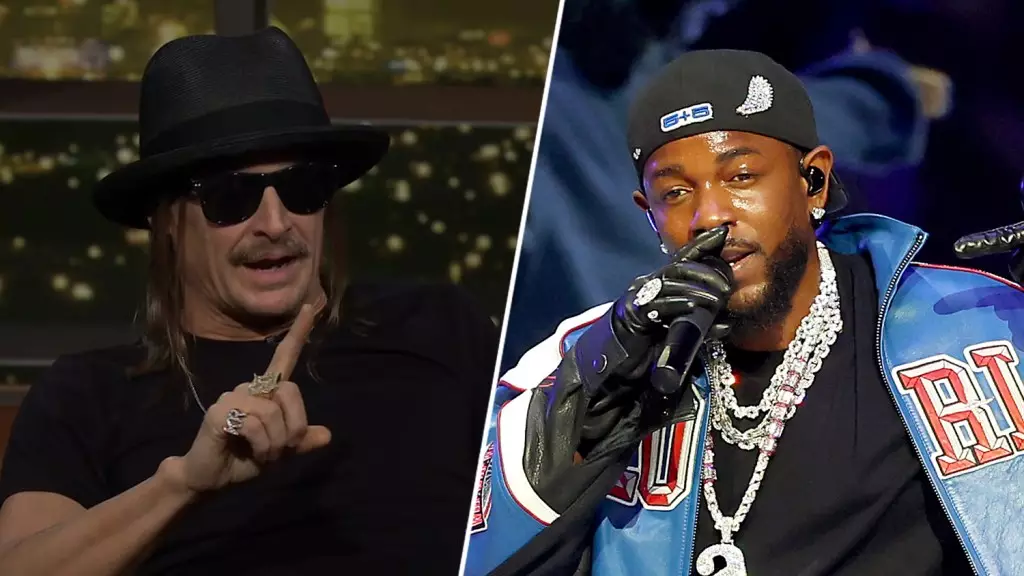Kendrick Lamar’s performance during the Super Bowl halftime show caused waves of discussion, sparking a mix of admiration and criticism. While many viewers expressed shock and awe at Lamar’s artistic choices, one of the more surprising reactions came from Kid Rock during an episode of *Real Time with Bill Maher*. As a notable figure in the music industry, Rock’s comments illuminate deeper cultural divides and reflect the complexities of race and representation in mainstream media.
Kid Rock positioned himself as an authority on hip-hop culture, highlighting his past influences and experiences with the genre. In his critique of Lamar’s performance, Rock eloquently voiced his feelings while at the same time somewhat undermining the broader cultural significance of the show. He described Lamar’s set as the “epitome of DEI blowing up,” indicating that he perceived a disconnect between the intended message of diversity, equity, and inclusion (DEI) and the performance itself, which he felt was exclusionary in its focus on Black artists and culture. While Rock “respected” Lamar’s rebellious spirit, his remarks raise critical questions about the expectations placed upon artists of color when they engage in spaces historically dominated by white narratives.
It’s notable that Rock claims a level of understanding regarding hip-hop heritage—asserting that he is more acquainted with the genre than most of his white peers. However, such a statement can be problematic. By emphasizing his white identity as a lens through which to critique Lamar, Rock arguably risks reducing an essentialist view of culture to simplistic binaries. Is his understanding of hip-hop valid only because of his nostalgic affiliations, or does it merit genuine authority in conversations that should prioritize Black voices?
Lamar’s halftime show, laden with symbolic messaging, served as a powerful statement, especially significant as it occurred during Black History Month. This timing provided an extra layer of meaning to his performance, offering a reminder of the ongoing struggles and achievements within the Black community. In stark contrast to Rock’s commentary, many appreciated Lamar’s unapologetic embrace of his identity and culture — embracing the freedom to express without concern for pleasing critics.
Rock highlighted the role of Jay-Z in facilitating Lamar’s performance, suggesting that this partnership emerged from a context fueled by the societal shifts initiated by Colin Kaepernick’s protest. This perspective suggests that artistry is not isolated; rather, it is embedded in a web of political and social discourse. Recognizing the trajectory from Kaepernick’s protest to the Super Bowl stage emphasizes the gravity of Black voices reclaiming power amid systemic challenges.
As a musician, Lamar draws upon the frameworks of activism and entertainment, expertly weaving messages that challenge norms while simultaneously entertaining a broad audience. Many artists utilize their platforms to express dissent and encourage critical dialogue. In this regard, the level of entitlement Rock exhibited—expecting representation that aligns with his perspective—rings hollow. Cultural events like the Super Bowl halftime show can serve dual purposes: celebration of artistry and a platform for advocacy, confronting issues directly impacting communities of color.
Moreover, Rock’s criticism about the perceived lack of inclusivity during the performance ironically echoes a common critique leveled at the music industry: that it often sidelines authentic representations of Black culture. His suggestion that DEI is failing because it doesn’t cater to all races can be seen as a classic example of white fragility when confronted with spaces that prioritize Black narratives. This commentary, instead of fostering dialogue, risks perpetuating marginalization.
Kendrick Lamar’s Super Bowl halftime performance became a flashpoint for cultural examination and critique, opening avenues for discussing race, representation, and artistic freedom. While responses like Kid Rock’s reveal the complicated dynamics at play, they also underscore the challenge artists face in navigating spaces that remain rife with historical inequities. Ultimately, Lamar’s artistic expression serves as a bold reassertion of identity, urging viewers to rethink their perspectives on culture, representation, and the continued importance of activism through art.


Leave a Reply